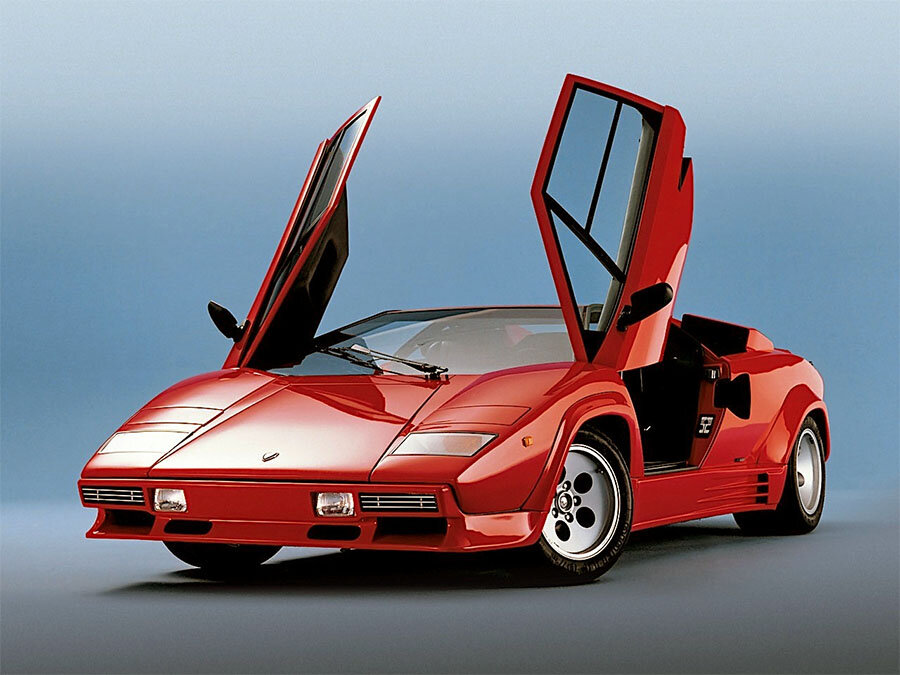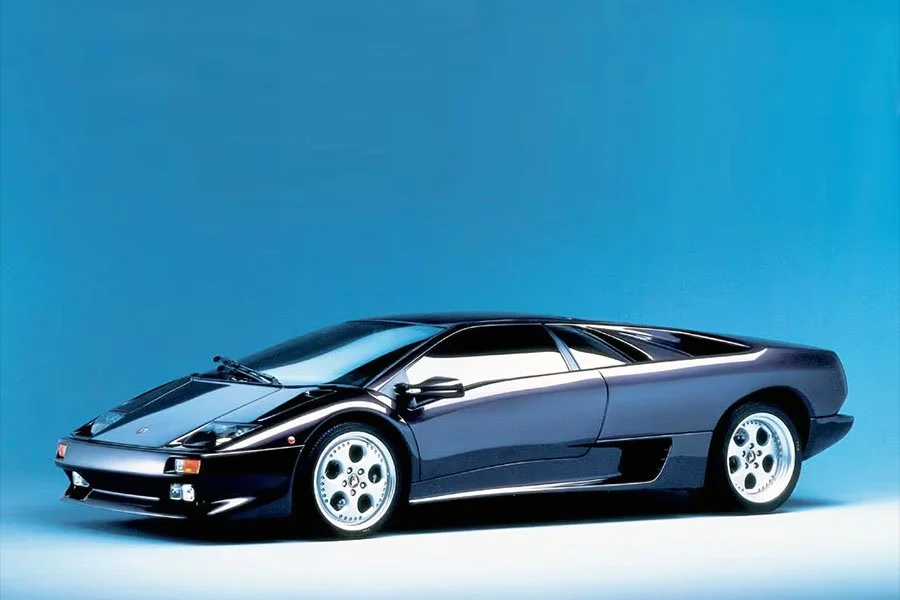Guide: Epic Gains - a Historical & Technical Appraisal of the Lamborghini Countach Quattrovalvole
/BACKGROUND
Automobili Lamborghini’s well-documented problems throughout the 1970s culminated with the firm going into liquidation in February 1980.
However, five months later, the marque began a resurgence under the management of young Swiss industrialists, Patrick and Jean-Claude Mimram.
Armed with an unlimited credit note from their bank, the Mimram brothers were first given permission to manage Lamborghini as a test of their ability. After several successful months at the helm, the Italian courts approved a sale to the Mimram Group for $3m.
New and revamped models came thick and fast. First to arrive was the targa-topped V8-powered Jalpa in 1981 followed by the Countach 5000 S with its enlarged 4.8-litre engine in 1982. The Mimrams also set about creating a luxury Countach-engined SUV from the abandoned Cheetah project; the resultant LM 002 launched in 1986 was unlike anything else available at the time.
One year before the LM 002 was introduced, Lamborghini released a further uprated Countach that most notably featured a 5.2-litre engine with four valve cylinder heads.
The Countach Quattrovalvole was unveiled at the Geneva Motor Show in March 1985. It debuted six months after Ferrari had stunned the automotive world with their BB replacement: the Testarossa.
With its iconic 80s looks and 380bhp Flat 12 engine, the Testarossa was able to match the Countach 5000 S for visual drama and performance. However, when the 455bhp Countach Quattrovalvole arrived, Lamborghini were once again in possession of the fastest production car on sale.
ENGINE / TRANSMISSION
At its heart was a revised Tipo LP112 D version of the all-alloy DOHC Lamborghini V12 that had been around in one shape or another since 1963.
Compared to the outgoing 5000 S, displacement was increased by 413cc. An overall capacity of 5167cc was achieved by extending the stroke by 6mm to 75mm. Bore was kept at 85.5mm.
Just as importantly, new four valve cylinder heads with pentagonal combustion chambers were fitted. The Quattrovalvole heads featured two 36mm inlet valves and two 32mm exhaust valves for each cylinder. Previously, the 5000 S engine had used single 48mm and 38.2mm valves respectively.
The addition of a four-valve head was considered a more attractive proposition than the alternatives of further increased displacement or turbocharging.
The compression ratio was upped from 9.2:1 to 9.5:1.
Another major change was the switch from sidedraught to downdraught carburettors; six Weber 44 DCNFs replaced the 45 DCOEs used on the 5000 S.
A 75 amp alternator was used instead of the old 70 amp component. Magnetti Marelli electronic ignition was retained.
Peak output rose dramatically. Lamborghini quoted 455bhp at 7000rpm and 369lb-ft at 5200rpm. This compared to 375bhp at 7000rpm and 302lb-ft at 4500rpm for the 5000 S.
Transmission was via Lamborghini’s five-speed manual gearbox, a beefier clutch and limited-slip differential.
CHASSIS
Other changes were comparatively modest as by this time, the Countach was a well honed machine and since their takeover, the Mimram brothers had done much to improve build quality.
The Quattrovalvole retained the complex round tubed spaceframe fabricated by Marchesi & C. in Modena.
The floorpan was a mixture of fibreglass and steel. Fuel tanks with a combined capacity of 120-litres were housed in each sill.
Suspension was independent all round. It comprised double wishbones at the front with upper lateral links, reversed lower wishbones and upper and lower trailing arms at the back. Coil springs and telescopic Koni dampers were installed at each corner (two per side at the rear). Anti-roll bars were fitted at either end.
Brake discs and calipers were supplied by ATE. As before, the discs had a 300mm diameter at the front and 284mm diameter at the rear.
15-inch diameter wheels measured 7.5 and 9.5-inches wide front to back. They were manufactured by OZ Racing and shod with Pirelli P7 tyres. Slightly wider front tyres (225/50 instead of 205/50) resulted in the Quattrovalvole having a 4mm wider front track.
BODYWORK
Externally, this latest variant was immediately identifiable thanks to an engine cover with a distinctive power bulge. The boxy addition was necessary to accommodate the new downdraught carburettors. However, it further reduced the Countach’s already limited rear visibility.
Kevlar was used for the new engine cover and the front lid.
Aside from Quattrovalvole script on the tail fascia, nothing else was changed.
This was only possible because Marcello Gandini’s revamp of the original Countach design still looked fresh and exciting. Gandini had successfully integrated a deep front spoiler and brawny wheelarch extensions to the Countach S, additions that had transformed the svelte LP400 into a macho masterpiece.
INTERIOR
Other than some minor switchgear changes, the cockpit’s basic architecture was unchanged. New vertical vents for the air-conditioning were added at either side of the dash.
The instrumentation layout remained as before. Housed directly behind the three-spoke leather-rimmed steering wheel in a rectangular binnacle was a large speedometer and rev counter with a smaller oil pressure gauge in between. Off to the left were more small gauges for oil temperature and battery amps. To the right were read outs for water temperature and fuel.
The audio system was located next to the glovebox. Ventilation controls were mounted on a central console that linked the dash and the bulky transmission tunnel.
Bucket seats could be manually adjusted fore and aft, but the backs were fixed in position.
The split side windows could only be lowered a few inches and were manually operated.
Leather was used to upholster the seats, transmission tunnel, sills, dash and upper rear bulkhead.
As before, cockpit space was limited for anyone over six feet tall.
OPTIONS
Options included a choice of wheel colour, a rear spoiler, sports exhaust and several different audio systems.
WEIGHT / PERFORMANCE
At 1490kg, weight was up by 10kg.
However, thanks to its extra 80bhp, the Quattrovalvole was the fastest Countach yet. It was capable of 188mph (up from 182mph) while the 0-62mph time dropped from 5.2 to 4.8 seconds.
Until the Porsche 959 arrived in 1987, the Countach Quattrovalvole was considered the fastest production car in the world.
USA VERSION
Although a few grey market Countach had trickled into the USA during the early 1980s, the addition of a fuel-injected Quattrovalvole in 1986 led to a dramatic uptick in American sales.
Bosch KE Jetronic fuel-injection replaced the Weber carburettors and meant the Countach was able to meet Environmental Protection Agency regulations. By fitting a big front bumper and new tail fascia, the Countach was also able to conform with Department of Transport safety rules.
With the downdraught carburettors removed, a reprofiled engine cover with raised side sections and three banks of cooling vents meant rear vision was largely restored.
Large rectangular side marker lights were also added.
Output was 420bhp at 7000rpm. The torque rating was unchanged.
CHRYSLER BUYS AUTOMOBILI LAMBORGHINI
On 24th April 1987, the Mimram Group sold Automobili Lamborghini to the Chrysler Corporation for $25.2m. The takeover was spearheaded by Chrysler chairman, Lee Iacocca.
PRODUCTION CHANGES
Later in 1987, the Countach Quattrovalvole was given a subtle revamp.
Evoluzione-style ventilated skirts were added down each flank, the Porsche synchromesh was switched to a ZF unit and the brake geometry was slightly reconfigured to improve initial bite.
Other improvements included central locking, better cockpit ventilation and a superior heater.
END OF PRODUCTION
Production continued until September 1988 when the Quattrovalvole was replaced by the final Countach iteration: the 25th Anniversary.
610 Quattrovalvoles were completed between 1985 and 1988.
Text copyright: Supercar Nostalgia
Photo copyright: Lamborghini - https://www.lamborghini.com




































